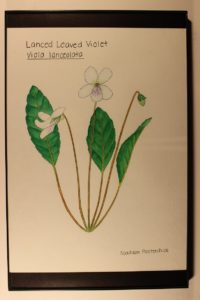| Common Name(s) | Lance Leaved Violet, White Bog Violet | ||||
| Scientific Name | Viola lanceolata | ||||
| Family | Violaceae | ||||
| Location/Vegetative Zone | Freshwater bogs, swamps, wet meadows and along shores in sandy soil | ||||
| Flowering Period | May-June | ||||
| Identifying Characteristics | 10-15cm tall, lance-shaped leaves, 5 white petals- middle bottom petal has purple veins | ||||
Description
- Perennial plant
- Grows 10-15 cm tall
- Leaves
- Narrow 2-6″ long, 1/4-3/4″ across
- Lance-shaped
- Smooth
- Wider in the summer than the spring
- White flowers
- Bottom three petals typically have purple veins
- Blooms for 3 weeks, from May-June
- After blooming, flowers turn into green elliptical shaped fruit capsules about ¼in long containing many small, dark brown seeds
- Habitat:
- Freshwater bogs, swamps, wet meadows, and along sandy shores
- Grows in sandy soil
- Originates in North America, but can be found in many states across the US and Canada
- Likes full sun and moist to wet conditions
Misc
- Is considered an ornamental plant, and can be used in flower arrangements
- Often hybridizes with the White Northern Violet (Viola macloskeyi) to form a combination plant, Primrose-leaved Violet (Viola primulifolia)
Sources
“Viola lanceolata“. Go Botany. New England Wild Flower Society. Web.
2,267 total views, 1 views today

